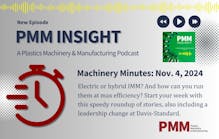By Karen Hanna
While recent court cases have raised questions about diversity, equity and inclusion efforts (DEI), nearly three-quarters of manufacturing executives say diversity remains important for their company, according to a recent survey conducted by The Manufacturing Institute (MI) and Washington, D.C., consulting firm Keybridge.
“What I’m hearing from companies is that they are going to be looking for ways to make sure that they are able to continue with their D and I practices and their activities, and reassure their employees that they remain committed because this is really important to the employee base, as well,” said Carolyn Lee, president and executive director of the MI.
“Research also shows — and this is something we read a lot and reference in the paper — employees, in addition to good-paying jobs, they’re looking to bring their whole selves to work and to know that their input is valued. D and I activities are really key to that.”
With 2.1 million manufacturing jobs expected to go unfilled in the next decade, the MI and Keybridge report, “Diversity, Equity + Inclusion: Benchmarking in Manufacturing,” says the initiatives don’t just create goodwill — they’re good business.
Seventy-two percent of respondents surveyed in for the May 2023 report said they strongly or somewhat agree that diversity is a key focus of their company, compared with 64 percent who reported the same sentiment in October 2021, when the MI and Keybridge released their first survey on DEI.
The 2023 report — developed from responses submitted by manufacturers in fall 2022 — comes on the heels of two Supreme Court rulings in June that have raised questions about the future of diversity policies. In one case, the court ruled the race-conscious admissions programs of University of North Carolina and Harvard College violated the Constitution’s equal protection clause; in a second case, the court ruled a business owner had a First Amendment right based on religious convictions to decline to serve a gay couple.
In July, Lee said the MI still is seeking input to see how the cases might inform workplace policies. But she said she believes companies will persist in trying to build a labor pool that reflects their community.
Looking for the best candidates
With so many positions coming open, they’ll have to.
“I would say they’re looking at ways to make sure they’re reaching all the populations that are in their communities and that they are going to not [just] the same schools that they had used to recruiting from in the past, and that they are branching out to make sure that they are recruiting from the widest audience possible,” she said.
To land and retain the best candidates, companies might need to rethink their human-resources practices, including hiring processes, according to recommendations included with the surveys. For example, to minimize the risk of bias, they should review and standardize job descriptions, interview questions and promotion processes.
Rather than having a supervisor or two conduct interviews or greenlight promotions, companies should seek input from a broad array of people, including the input of prospective or current colleagues.
“Hiring practices that can help minimize bias include blinded resume reviews, standardized interview questions and scoring systems, skills tests and utilizing panel interviews,” the 2023 report states. Similarly, promotions should rely on standardized scoring systems, with companies highlighting to all their employees clear career pathways.
To ensure that all employees are able to gain skills that might allow them to move up, and to prevent employees from languishing too long in roles they don’t like, companies should rotate work assignments.
For manufacturers, part of the challenge is simply convincing members of the public that there’s a place for them in the industry, Lee said.
“Whether you want to come in and design and create, or you like numbers, or you want to get people to Mars, because that’s a thing we’re talking about now, and flying cars, there’s a place for you here, but we have to be able to articulate that,” she said.
Leadership, outreach are keys
The 2023 report suggests that one area for improvement could be DEI initiatives that target executive positions. While survey respondents said they see the need for greater diversity in such positions, the report states, “companies were evenly split on whether they had a senior leadership position within their business directly accountable for DE&I.”
One key to retaining a diverse workforce is “fostering a sense of belonging at work,” the 2023 report states.
According to the report, strategies to boost retention can include “making employee voices heard, providing training and development opportunities, offering mentorship programs and optimizing the onboarding experience. These methods would benefit all employees, but an outsized benefit would be felt by employees from diverse backgrounds.”
Companies can benefit from partnering with community organizations, including community colleges and technical schools that are engaged with diverse communities. For example, professional organizations focused on women can help companies attract and retain women in roles beyond those they’ve typically held in office settings within the manufacturing industry.
“Though more than 80 percent of survey respondents report that they have created partnerships with community colleges and technical schools, room for improvement exists,” the 2023 report states. “These partnerships could be strengthened by deepening the relationship with existing and prospective institutions, offering work-based opportunities for students and providing a direct pipeline into manufacturing employment where possible.”
Efforts are showing results
Manufacturers are making progress in efforts to diversify, Lee said. For example, women now make up 29 percent of the manufacturing industry’s workforce, and Lee said she is optimistic the industry will see that number rise to 35 percent by 2030 — a benchmark set by the MI.
Workplace flexibility, including child-care options and support, are among factors that could further narrow the gender gap, according to the 2023 report.
For manufacturers still looking to diversify, or simply looking to fill positions, Lee pointed to a few other labor pools — including immigrants and people transitioning out of the military — that she said represent still-untapped potential.
She said Second Chance manufacturing plants, which provide jobs to people with criminal records, also have seen success.
“There’s one in four Americans who have some exposure to the criminal justice system in their past, and they’re looking for a new way,” she said. “And so you have this untapped talent pool that’s waiting to find a new way in, and manufacturers who have been doing this have been very successful in engaging this talent to great effect, because ... research has shown that those coming out of a second chance, in that category, their retention rates are really high.”
She said she believes manufacturers must do more to expose people to the opportunities they offer. Events such as Manufacturing Day can play an important role in raising awareness, she said.
Outreach efforts to underrepresented communities will help individuals as well as the industry, according to Lee and the reports.
As the 2021 report states, “A diverse workforce is more innovative and better at problem-solving. Research shows that a more inclusive workplace leads to increased hiring, higher retention rates, more engaged employees and an improved bottom line.”
Contact:
The Manufacturing Institute, Washington, D.C., 202-637-3426, www.themanufacturinginstitute.org
Karen Hanna | Senior Staff Reporter
Senior Staff Reporter Karen Hanna covers injection molding, molds and tooling, processors, workforce and other topics, and writes features including In Other Words and Problem Solved for Plastics Machinery & Manufacturing, Plastics Recycling and The Journal of Blow Molding. She has more than 15 years of experience in daily and magazine journalism.






